|
3 SWORDS
IN TWO PARTS
|
|
FOR THIS WEEK
AND NEXT WEEK, WE WILL BE LOOKING AT 3 DIFFERENT AMERICAN MILITARY
OFFICER'S SWORDS FROM THE EARLY 1800'S. EACH SWORD IS FROM A DIFFERENT
BRANCH OF SERVICE. FROM LEFT TO RIGHT FOLLOWING ARE NAVY, MOUNTED
ARTILLERY AND INFANTRY OFFICER'S SWORDS. THEY DATE, RESPECTIVELY,
FROM APPROXIMATELY 1808 TO 1850.
|
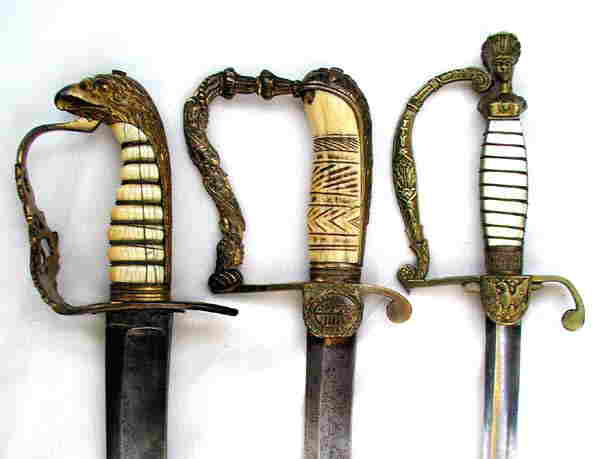
|
|
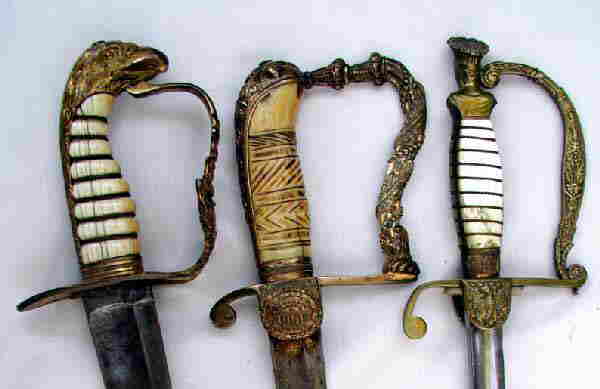
|
|
Left to
right: Naval Officer's Eagle Head Sword 1808-1830, Mounted Artillery
Officer's Sword 1815-1840, Infantry Officer's Indian Head Sword
1835-1850 (All dates approximate).
|
|
|
|
PART 1
|
|
MOUNTED ARTILLERY
OFFICER'S SABER
|
|
1815-1840
|

|
|
This sword measures 35" overall. The 30-3/8" curved, single edged
blade is without a true false edge. A shallow broad fuller extends
from the ricasso to within 7-1/8" of the blade point. The blade, at
the hilt, is 1-1/8" wide and ¼" thick. It is 1" wide until
it tapers to it's point starting about 23¼" from the ricasso.
The blade at one time was partially blued with the decorations having
gilt etchings. Traces of that gilt remain.
|
|
There is no maker's names or marks visible. There are floral sprays
and military trophies etched on both sides of the blade. On the obverse
side there is a stylized Indian arrow imposed over a oak leaf like
etching and a etched Indian head with an elaborate head dress. These
etching are very light and difficult to photograph. However, our attempts
follow:
|
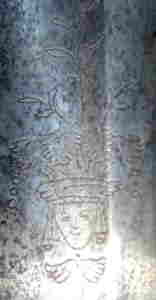 |
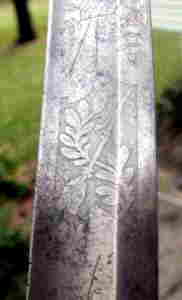 |
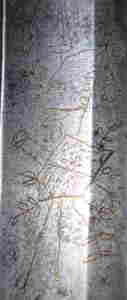 |
| Indian
Head - Obverse |
Arrow
Panel - Obverse |
Trophy
Detail - Obverse |
|
|

|

|
| Lower
Blade - Reverse |
Trophy
Detail - Reverse |
|
|
The grips are carved bone with horizontal and diagonal grooving. The
reverse P pattern knuckle-bow is decorated with an intertwined beaded
cord or sword knot design. The brass backing of the grip is heavily
embossed with a oak leaf design that terminates at the top of the
pommel with 4 diagonally opposed acorns. There are shield like shaped
langents on each side of the blade. They each bear a wreath encircling
an oval medallion carrying the motto “PARTA TUERI” along with a group
of 15 six-pointed stars over 15 stripes arranged in the manner of
a U.S. shield. All metal parts of the hilt are gilded brass as is
the scabbard.
|
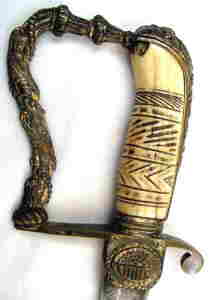 |
 |
| Obverse
View of Hilt |
Reverse
View of Hilt |
 |
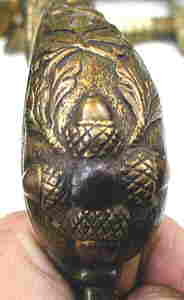 |
| Back
of Grip |
Top
of Pommel |
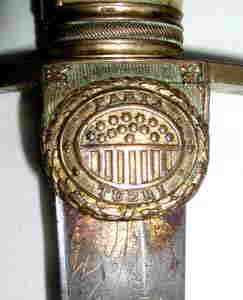 |
| Langent
Detail
|
|
|
The gilded brass scabbard is heavily etched on the obverse side with
floral and geometric diamond shaped designs along with an American
eagle with shield. There is a rudimentary drag and a suspension consisting
of 2 brass carrying rings 8½" apart. The first ring is mounted
2-5/8" from the scabbard mouth. This scabbard is missing it's throat.
It also has a heavy crease in it about 9" up from the drag.
|
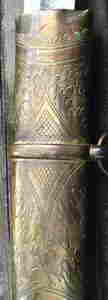 |
 |
 |
| Mouth
and Top Ring |
Middle
Ring |
Drag |
|
 |
|
U.S. Eagle
with Shield
|
|
|
|
I got this sword from Vince Malon about 15 or so years ago. At that
time Vince claimed he had purchased it from a relative of Stewart
Van Vliet, West Point Graduate Number 1025, class of 1840. Van Vliet
was born in New York, appointed from Maine. He was an artillery quarter
master, Florida Indian War, 1840-42. In the Mexican War he served
in the Maine militia as a colonel. A brigadier general of U.S Volunteers
in 1861, he received 5 brevets to major general. From 1875 -1881 he
was the Inspector General for the Quarter Master Department, Washington,
DC. He died in Washington, DC., March 28, 1901 at the age of 86.
|
|
His grandson, great grandson and great-great grandson all attended
West Point.
|
|
I made these notes on the back of my business cards when I got this
sword or shortly thereafter. I have absolutely no official documentation
on this sword as to it belonging to General Van Vliet. Only Vince's
word as to this being so.
|
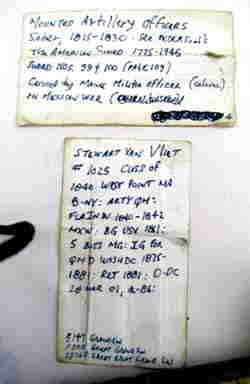
|
|
My Notes
|
|
|
Well, next week, we will have Part 2 of this three sword posting.
There was just too much detail for a single posting. |
|
Reference credits go to “THE AMERICAN SWORD, 1775-1945" by Harold
L. Peterson. The posting credits go, as usual to my webmaster and
son, Reed Radcliffe.
|

|
|
One Last
Picture - Overall View Without Scabbard
|
|
See you all next week.
|
| Dave
Radcliffe
|


















